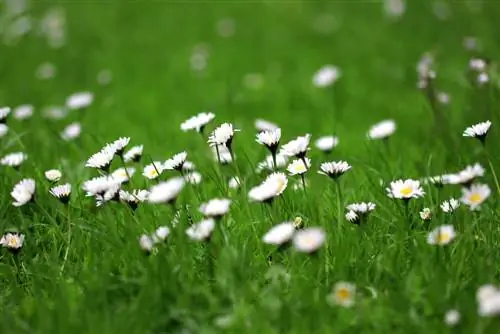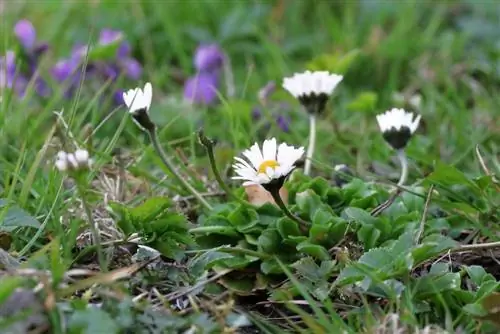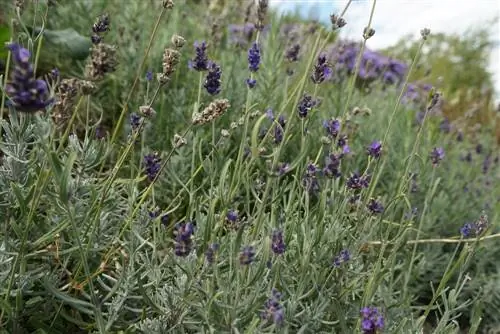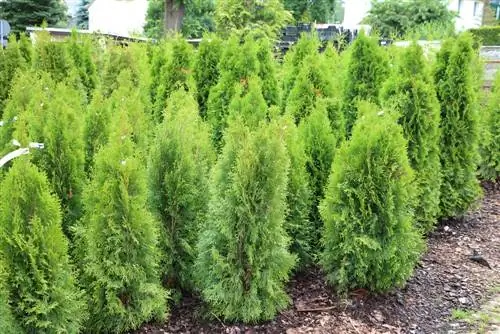- Author admin [email protected].
- Public 2023-12-17 03:39.
- Last modified 2025-01-24 12:45.
The daisy has the botanical name Bellis perennis and is one of the plants that grows in this latitude. The flower can be found wild on the edges of fields and meadows, and it also likes to settle in parks and gardens. The plant is available in two-year or perennial varieties, which can usually survive the frosty temperatures of the winter months in the garden.
Frost resistance
Although the native bellis look very delicate, they are usually quite winter-hardy plants. This is why daisies cope well with extremely cold temperatures during the winter. For this reason, the flowers can be planted in the garden without any problems. However, the frost hardiness depends on the lifespan of the plants. If there is a lot of sun at the end of winter, the Bellis may even start to bloom in the snow. However, as soon as extremely low temperatures set in, the flowers need additional winter protection. It is also possible to cultivate them in a flower pot or bucket on the balcony or terrace so that the daisies can then be moved to a suitable winter quarters.
- Generally frost hardy down to -15° Celsius
- Biennial daisies are more sensitive to cold
- Perennial varieties are more frost-resistant
- Exotic varieties from abroad are only partially hardy
- These varieties need to overwinter indoors
- These include the Spanish and Blue Daisy
Winter protection
Perennial daisies are far more resistant to frost, so they do not need to be covered even in severe frosts. Although the two-year-old varieties are hardy, they need additional winter protection when the first frosty nights arrive. However, if the location of the Bellis is very exposed or is in higher mountain areas, then all varieties must be protected from the cold. If the temperature values drop extremely low in winter and are more than -15° Celsius, then additional winter protection is also required. In this way, the daisies can be grown in the garden all year round.
- Put out winter protection at the end of autumn
- Cover flowers with protective material
- Pile up the seasonal leaves on the plants
- Mulch, straw and brushwood are also suitable
- Alternatively use warming fleece
Wintering
Some of the Bellis varieties come from warmer climates and are therefore not frost-resistant. Because of this, they cannot be planted in the garden all year round. This is why external daisies can be cultivated in flower pots or buckets. The plants also thrive in a sheltered spot on the balcony or terrace during the warm season. At the end of the autumn season, however, the plants have to move to frost-free winter quarters. The winter quarters must not be too warm, which is why heated living spaces are not suitable for this. In spring the Bellis are allowed outside again. But only move after the Ice Saints, as no more frosty nights are to be expected at this time.
- Get warm as soon as temperatures drop below 0° Celsius
- Bright but not too sunny winter quarters are ideal
- Unheated winter gardens are well suited
- Alternatively place in unheated corridors or unused guest rooms
- Temperature values between 1° to 5° Celsius are optimal
- Air winter quarters regularly
- Avoid fertilization measures
- Outdoor season starts again from mid-May
Tip:
Unlike the Spanish daisy, the blue daisy comes from Australia and is therefore used to extremely hot temperatures. That's why this variety needs a bright winter quarters with slightly higher temperatures, values between 6° to 14° Celsius are ideal.
Advanced Bellis

If Bellis are purchased as pre-grown plants from specialist retailers, then they are particularly sensitive to frost. Since the plants are on the shelves of garden centers at the beginning of spring, they are planted out at the same time. However, there can still be icy nights until May, causing frost damage to the daisies. In extreme cases, the bellis even die completely if the frost was too severe. Therefore, Bellis that have been grown in the greenhouse and are therefore sensitive to cold should be hardened off before they are finally planted out. If you want to be on the safe side, don't plant the daisies you bought until the end of April or, better yet, the beginning of May. For the noble premium varieties with the richly double flowers, the planting time should only begin after the Ice Saints. At this point, damaging ground frosts are no longer expected.
- Short acclimatization phase optimizes frost resistance
- Place the new Bellis on the balcony during the day after purchasing it
- Partly shaded and protected location conditions are ideal
- Do not place in the blazing sun and midday heat
- Put away in the house before sunset
- Alternatively, the greenhouse is also possible
- Continue this procedure for 8 to 10 days
Frost hardiness through direct sowing
If you sow your daisies directly into the bed, you can significantly improve their frost hardiness. Then bellis, as biennial and perennial plants, usually survive the first winter undamaged. For young plants, additional protective measures are only necessary at extremely low frost temperatures.
- Overwintering in the form of a leaf rosette
- Blattschoppf is green and grows natively
- At the beginning of spring, slender flower stalks grow from the rosette
- Stems are initially leafless
- Elegant flower baskets form at their tips
- Flowers are frost-resistant down to -8° Celsius
- In mild locations, flowering begins as early as February to March
- Bellis bloom until late autumn






